- home
- BAKERECIPES
BakeRecipes
Bringing real baking into your home with deliciously simple recipes.
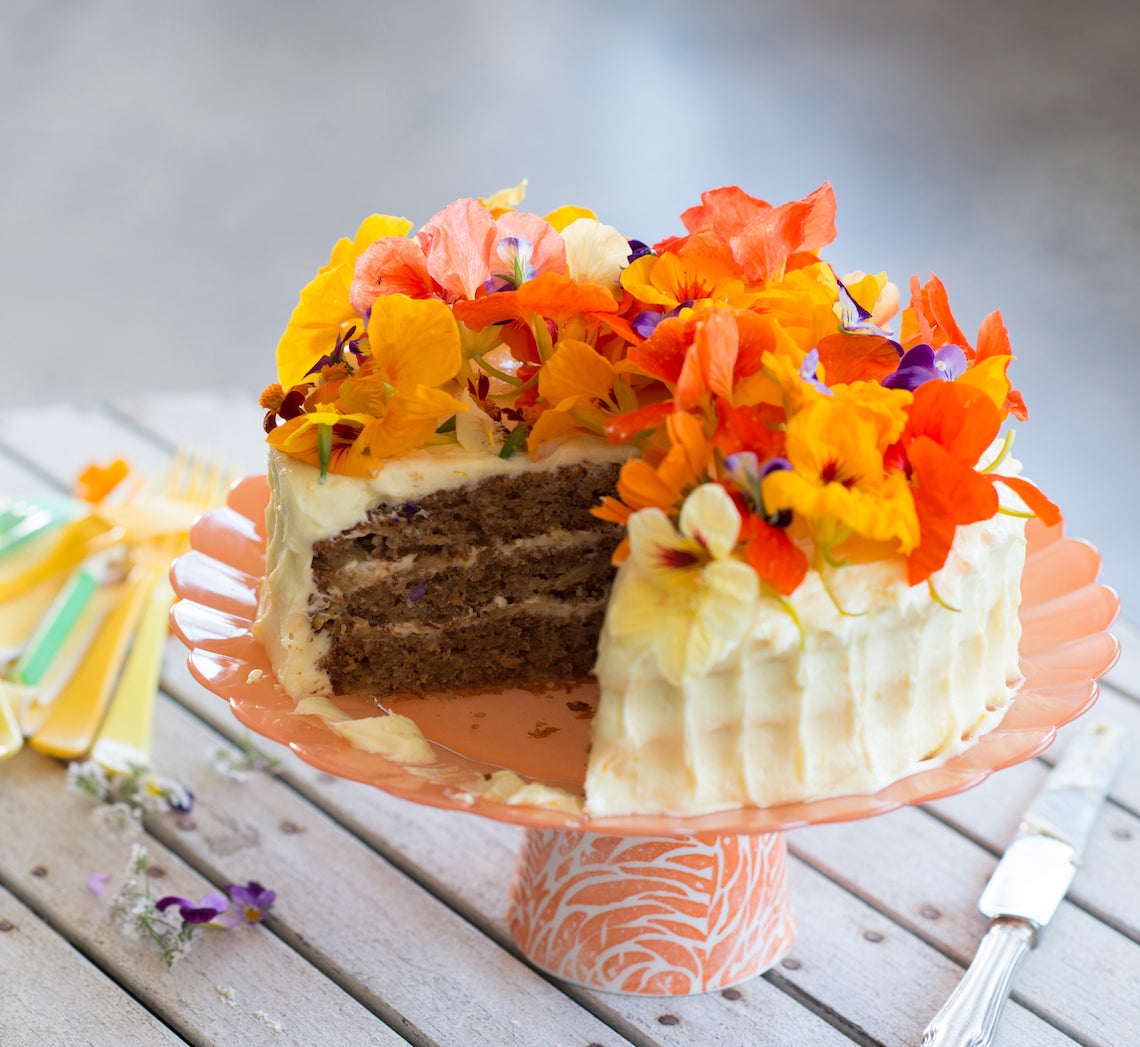
Prep 30minBake 30-35minMakes 12-15 serves
Originating (and excessively popular) in America, Hummingbird cake is a tropical mix of banana and pineapple, and when layered with an orange cream cheese frosting makes a great celebration cake. Sweet and indulgent, a small slice is all that is needed to satisfy.
Ingredients
150g (1 cup) plain flour
75g (½ cup) self-raising flour
½ teaspoon bicarbonate of soda
2 teaspoons ground cinnamon
220g (1 cup, firmly packed) brown sugar
45g (½ cup) desiccated coconut
2 very ripe large bananas (about 250g each)
440g crushed pineapple in natural juice, drained and juice reserved
2 eggs, lightly whisked
185ml (¾ cup) sunflower oil, plus extra to grease
Orange cream cheese frosting
100g unsalted butter, at room temperature
250g cream cheese, at room temperature
1 orange, zest finely grated
375g (3 cups) icing sugar mixture, sifted
Method
- Preheat oven to 180°C (160°C fan-forced). Brush three 20cm round cake tins with extra sunflower oil to lightly grease and line the bases with non-stick baking paper.
- Sift together the plain and self-raising flours, bicarbonate of soda and cinnamon. Add the brown sugar and coconut and stir to combine, breaking up any lumps.
- Mash the banana and combine with the drained pineapple, 80 ml (⅓ cup) of the reserved pineapple syrup, eggs and oil. Add to the flour mixture and use a wooden spoon or spatula to mix until just combined.
- Divide the mixture evenly among the prepared tins and spread with the back of a metal spoon to smooth the surface. Bake in preheated oven for 30-35 minutes or until cooked when tested with a skewer.
- Stand the cakes in the tins for 5 minutes before turning onto wire racks to cool (this will take about 1 hour).
- Meanwhile, to make the Orange cream cheese frosting, use an electric mixer to beat the cream cheese, butter and orange zest until very smooth. Gradually add the icing sugar, beating well after each addition and beat until well combined and really creamy. Divide the Orange cream cheese frosting evenly among 3 bowls.
- Take one portion of the Orange cream cheese frosting and use a palette knife to spread half over one cake layer. Top with a second cake layer and spread with the remaining frosting of the first portion. Top with the remaining cake layer. Spread another portion of frosting over the sides and the remaining portion over the top of the cake. Sprinkle with the pecans to decorate
Baker's Tips
- This cake will keep in an airtight container in the fridge for up to 4 days. Stand at room temperature for about 30 minutes before serving.
This recipe is from Anneka's SBS Food online column, Bakeproof: Cakes for Crowds. CLICK HERE for more Bakeproof recipes.
Photography by Alan Benson.

Prep 30min (+2hr cooling time and overnight freezing)Bake 1hrMakes 12-15 serves
There is something wonderful about ice-cream cakes. This one is a layer of cheat's strawberry ice-cream sandwiched with orange-scented pistachio meringue. It makes a wonderful dessert for any summer celebration.
Ingredients
1 litre (3½pt) good-quality vanilla ice cream
Strawberries, hulled and halved, to serve
Coarsely chopped pistachio kernels, to serve
Edible flowers (optional), to serve
Strawberry sauce
500g (1lb 2oz) strawberries, hulled and sliced
2 tablespoons (40g/1½oz) caster sugar
1 tablespoon (4 teaspoons) fresh lemon juice
2 teaspoons rosewater, to taste (optional)
Pistachio meringue discs
4 egg whites, at room temperature
220g (1 cup/7¾oz) caster sugar
45g (⅓ cup/1½oz) ground pistachios
1 orange, rind finely grated
Method
- Preheat oven to 150°C/300°F (130°C/265°F fan-forced). Mark two 20cm/8in circles on 2 pieces of non-stick baking paper. Turn the paper over and line two oven trays.
- To make the Pistachio meringue discs, use an electric mixer with a whisk attachment to whisk the egg whites until soft peaks form. With the motor running, gradually add the sugar, whisking well after each addition, until very thick and glossy and the sugar has dissolved. Whisk in the orange rind. Use a large metal spoon or spatula to fold in the ground pistachios until evenly combined. Divide the mixture between the two trays and use a palette knife or the back of a metal spoon to spread to fill the two marked circles.
- Reduce the oven temperature to 100°C/200°F (80°C/175°F fan-forced) and bake for 1-1¼ hours, swapping the trays halfway through baking, or until crisp on top. Turn off the oven and allow the discs to cool in the oven (this will take about 2 hours).
- Meanwhile, to make the Strawberry sauce, combine the strawberries, sugar and lemon juice in a medium saucepan and cook over low heat, stirring occasionally until the sugar dissolves. Bring to to a simmer and simmer for 5 minutes or until syrupy but the strawberries still hold some of their shape. Strain the sauce through a sieve set over a heatproof bowl. Transfer to strawberry pieces in a bowl and stir the rose water through the sauce. Cover both with plastic wrap and place in the fridge to cool.
- When ready to assemble the cake, line the base and sides of a 22cm/8¾in springform tin with non-stick baking paper. Place a pistachio disc in the base of the lined tin, trimming to fit if necessary.
- Scoop the ice cream into a large bowl and set aside for 5 minutes at room temperature to soften slightly. Add the cooled strawberry pieces to the ice cream and use a large metal spoon or spatula to briefly fold together to form a rough swirl pattern. Working quickly, spoon the ice cream immediately into the prepared tin over the meringue disc and use the back of a metal spoon to press down to remove any air pockets and smooth the surface. Cover the ice cream with the remaining meringue disc, trimming to fit if necessary. Cover with plastic wrap and freeze overnight.
- To serve, remove the cake from the springform tin and place on a serving plate. Top with strawberries and sprinkle with chopped pistachios and edible flowers, if using. Spoon over some of the strawberry sauce. Serve in wedges with the remaining strawberry sauce passed separately.
Baker's Tips
- This cake will keep covered in the freezer for up to 2 weeks.
- The strawberry sauce will keep in an airtight container in the fridge for up to 3 days. Alternatively freeze it for up to 1 month and thaw in the fridge.
This recipe is from Anneka's SBS Food online column, Bakeproof: Cakes for Crowds.
CLICK HERE for more Bakeproof recipes.
Photography by Alan Benson.
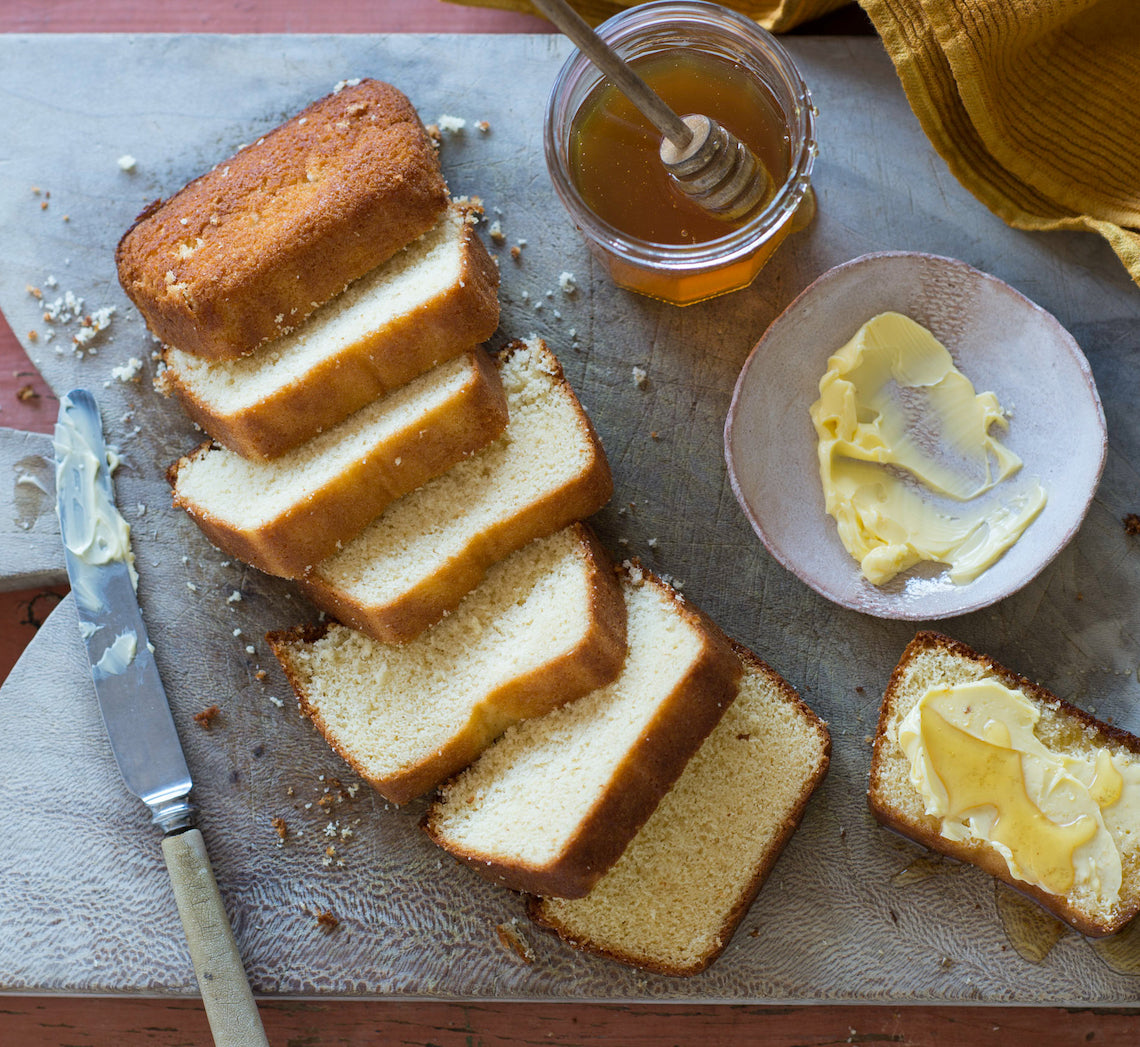
Prep 20min (+overnight chilling time)Bake 30minMakes 2 loaves
A specialty of the Nagasaki area in Japan, this wonderfully simple, honey-scented sponge cake was originally introduced by the Portuguese merchants in the 16th century, with its name originating from Pão de Castela meaning "bread from Castile". This cake defies sponge logic – strong bread flour gives it a "bouncy" texture, but it's still particularly moist and delicate, and becomes more so with time. Don’t be tempted to eat it straight from the oven (believe me, the heavenly honey aromas will tempt you!) – it needs to be wrapped while still warm and kept in the fridge overnight for its texture to be transformed.
Ingredients
- 6 eggs, at room temperature
- 220g (1 cup) caster sugar
- 115g (⅓ cup) honey
- 2 tablespoons warm water
- 200g (1¼ cups) bread flour, sifted twice
- Butter and extra honey, to serve
Honey Glaze
- 1 tablespoon honey
- 2 teaspoons warm water
Method
- Preheat oven to 180°C. Grease two 9 x 19cm (base measurement) loaf pans with butter and line each with two strips of baking paper.
- Use an electric mixer with a whisk attachment to whisk the eggs until frothy. Add the sugar and whisk on medium speed for 6-8 minutes or until the mixture is very thick and pale, has increased by four times its volume and a ribbon trail forms when the whisk is lifted.
- Add the combined honey and water and whisk until just combined.
- Add a third of the twice-sifted bread flour to the egg mixture and whisk on low speed for about 15 seconds or until just combined. Add the remaining flour in two separate batches, whisking on low until just combined as with the first batch, and checking that no flour has been caught in the bottom of the bowl.
- Divide the mixture evenly between the two prepared tins. Bake in preheated oven for 30 minutes or until a skewer inserted into the center comes out clean and the cakes will feel spongy when pressed in the center.
- To make the Honey Glaze, combine the honey and water in a small bowl and stir to combine. Brush the tops of the cakes with the Honey Glaze. Lay two pieces of plastic wrap large enough to wrap each cake on the bench top and turn the hot cakes out directly onto them. Wrap the cakes in the plastic wrap (this will help them retain their moisture), place on a tray, top side down, and put in the fridge, for at least 12 hours or overnight.
- Bring the cake to room temperature before serving in slices on its own or with butter and extra honey, if desired.
Baker's Tips
- This cake will keep at room temperature in an airtight container for up to 5 days.
This recipe is from Anneka's SBS Food online column, Bakeproof: Sponge Cake.
CLICK HERE for more Bakeproof recipes.
Photography by Alan Benson.
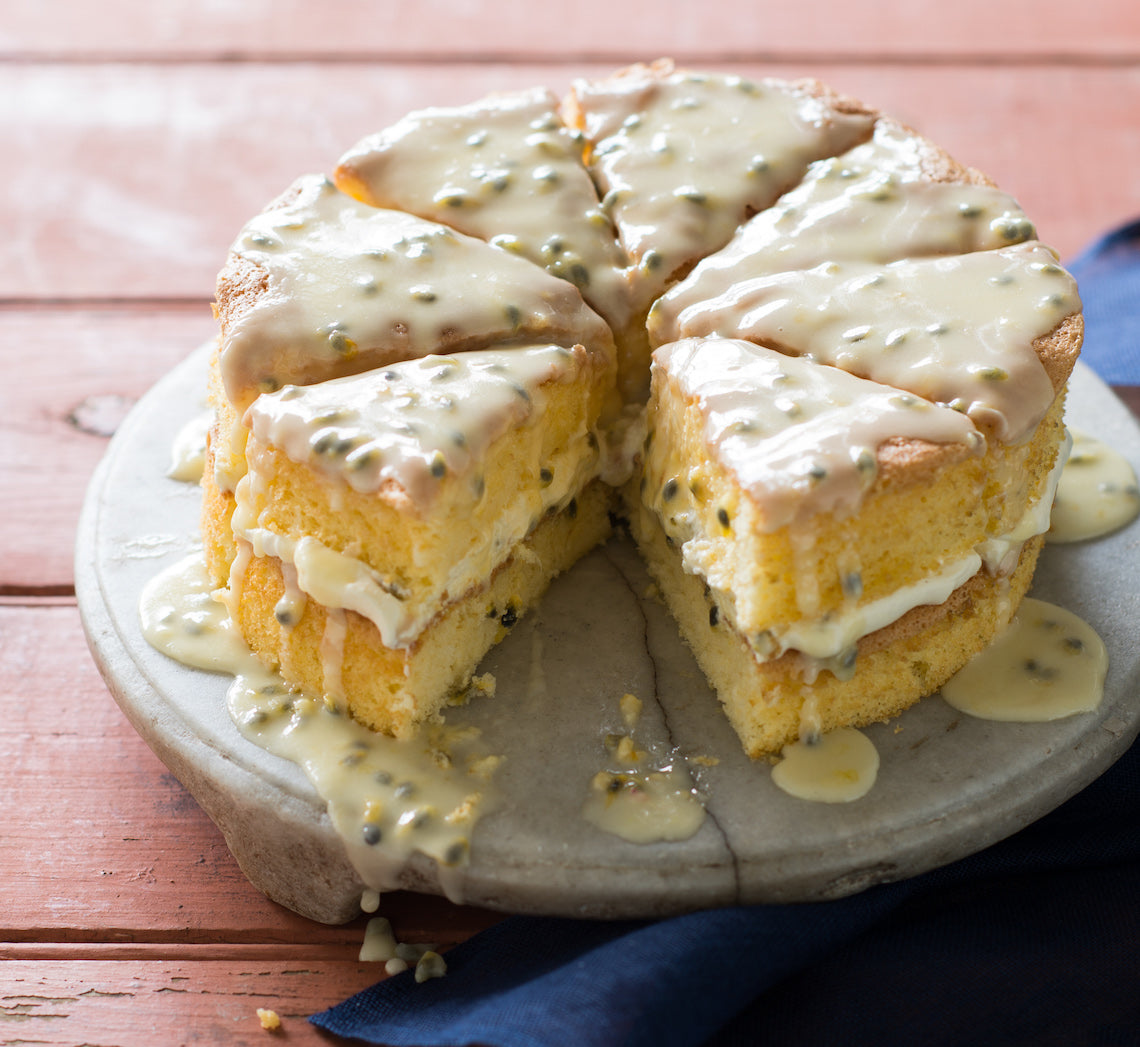
Prep 25min (+cooling time)Bake 18-20minMakes 8-10 serves
This sponge will have you wanting an excuse to make afternoon tea every day. There are two main tricks when making a sponge: don’t over-whisk the mixture once you have added the flour – only whisk it until the mixture is just combined. Also, sponges don’t take long to bake and, if overcooked, will easily become dry, so keep a close eye on them when baking.
Ingredients
160ml (⅔ cup/5¼fl oz) thickened cream
80ml (⅓ cup/2½fl oz) fresh passionfruit pulp
Sponge Layers
Melted butter, to grease
4 x 60g (2oz) fresh eggs, at room temperature
165g (¾ cup/5¾oz) caster sugar
60ml (¼ cup/2fl oz) milk
30g (1oz) salted butter, diced
110g (¾ cup/4oz) self-raising flour, plus extra to dust
30g (¼ cup/1oz) cornflour
Passionfruit Icing
180g (1½ cups/6½oz) pure icing sugar
1½ tablespoons fresh passionfruit pulp
Approx. 3 teaspoons boiling water
Method
- To make the Sponge Layers, place the oven rack in the lower third of the oven and then preheat it to 180°C/350°F (160°C/315°F fan-forced). Brush two 20cm/8in shallow (sandwich) cake tins with a little melted butter to lightly grease. Line the bases with circles of baking paper. Lightly brush the paper with a little more melted butter and then dust the bases and sides of the tins with a little flour to lightly coat, tapping out any excess.
- Use an electric mixer with a whisk attachment on medium-high speed to whisk the eggs in a medium bowl until frothy. Add the sugar a spoonful at a time, whisking well between each addition, until the mixture is very thick and pale and the sugar has dissolved (this will take about 8 minutes). Lift the whisk out of the mixture and draw a figure eight, if the trail stays on the surface long enough for you to finish drawing then the mixture is ready. If not, continue to whisk for a further minutes and then test again.
- Meanwhile, heat the milk and butter in a small saucepan over medium heat until the butter melts and the mixture is almost simmering. Remove from the heat. Pour the hot milk mixture down the side of the bowl with the egg mixture. Quickly sift the flour and cornflour together over the egg mixture and then immediately whisk again with the electric mixer briefly, until the flour mixture is just incorporated (make sure there is no flour caught at the bottom of the bowl and be careful not to overmix).
- Divide the mixture evenly between the cake tins (see Baker’s Tips) and gently tap the tins on the bench top three times to settle the mixture. Bake in preheated oven for 18-20 minutes or until the cakes are a pale golden colour, spring back when lightly touched in the centre and start pulling away from the sides of the tins. Remove from the oven and stand for 1 minute before turning onto a wire rack, top side up (see Baker’s Tips), to cool completely.
- When ready to fill, to make the Passionfruit Icing, sift the icing sugar into a medium bowl. Add the passionfruit pulp and enough boiling water to mix to a thin, spreadable icing. Cover tightly with plastic wrap and set aside. Use an electric mixer with a whisk attachment or a balloon whisk to whisk the cream in a medium mixing bowl until soft peaks form. Use a large metal spoon or spatula to gently fold the passionfruit pulp through the whipped cream until just swirled through. Place one layer of the sponge on a serving plate or cake stand and spread with the passionfruit cream. Top with the remaining sponge layer. Spread the Passionfruit Icing evenly over the top layer of the sponge, allowing it to drip down the sides slightly. Set aside or 20 minutes or until the icing sets before serving in slices.
Baker's Tips
- You will need about 5 large passionfruit for this recipe.
- To divide the mixture evenly between the tins, weigh the tins with the mixture in them to make sure they are the same weight.
- When removing the cakes from the tins, turn them onto a wire rack covered with a tea towel before inverting onto another rack. The tea towel will prevent the rack marking the tops of the cakes.
- The unfilled sponge cakes will keep in an airtight container at room temperature for up to 1 day. Once filled, the cake will keep in an airtight container in the fridge for up to 2 days. Stand at room temperature for at least 30 minutes before serving.
This recipe is from Anneka's SBS Food online column, Bakeproof: Sponge Cake.
CLICK HERE for more Bakeproof recipes.
Photography by Alan Benson.
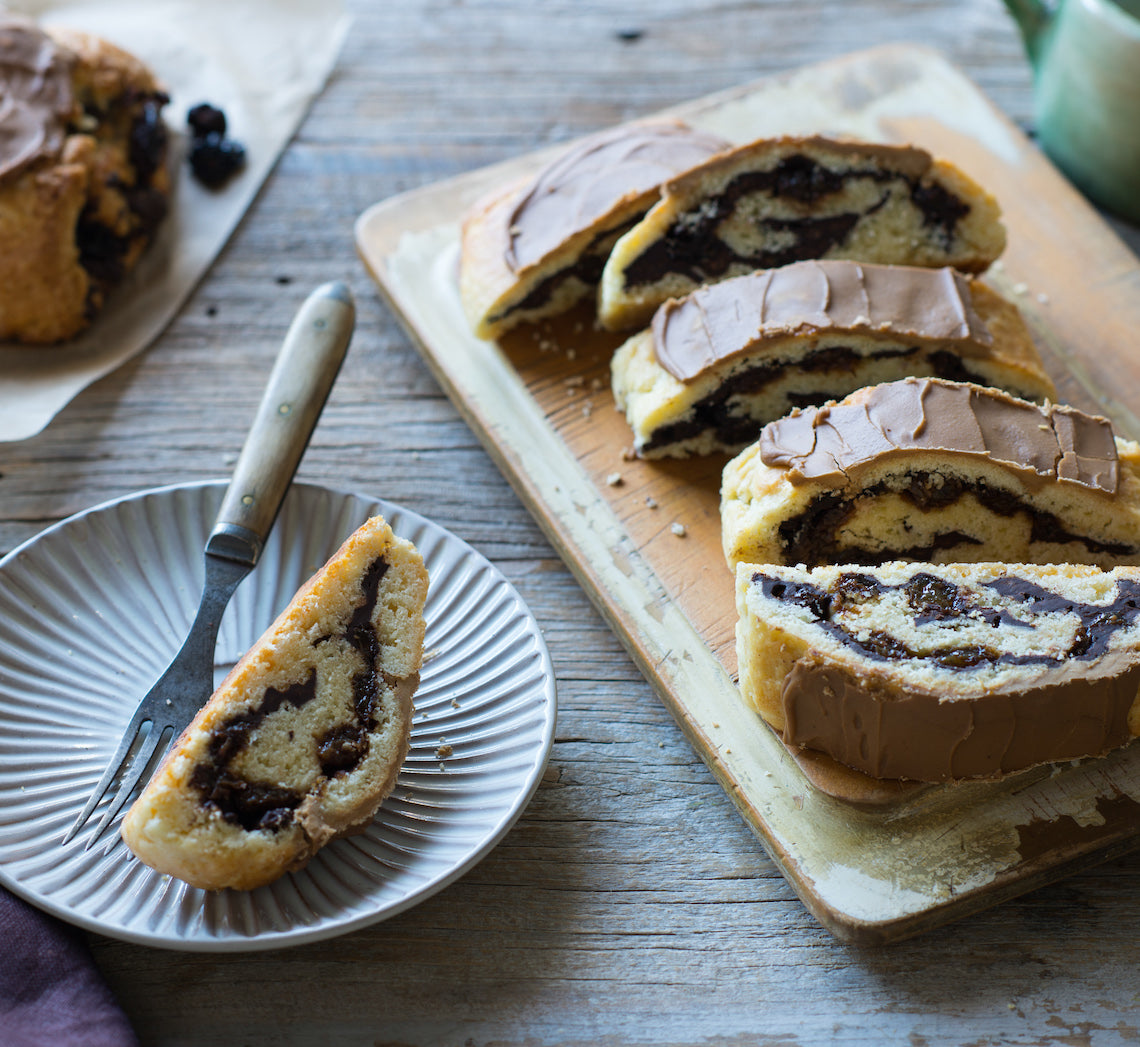
Prep 30min (+30min standing time)
Bake 40min Makes about 24
Even though these rolls are based on a scone dough, they resemble more a cakey biscuit. Confused? Just go ahead and bake them, you won't be disappointed… And you'll probably find yourself sneaking an extra slice!
Ingredients
170g (1 cup) seedless raisins
60ml (¼ cup) freshly brewed strong coffee
225g (1½ cups) self–raising flour
75g (½ cup) plain flour
Pinch of salt
80g butter, softened slightly, cubed
2 tablespoons caster sugar
125ml (½ cup) pure (pouring/thin) cream
80ml (⅓ cup) milk, plus extra for glazing
150g good-quality dark chocolate, chopped
Coffee icing
125g (1 cup) pure icing sugar
1 tablespoon freshly brewed strong coffee
Method
- Preheat the oven to 180°C (160°C fan-forced). Line a large baking tray with non–stick baking paper.
- Put the raisins and coffee in a small saucepan and bring to a simmer over medium heat. Remove from the heat and set aside for 15 minutes or until almost all the liquid has been absorbed. Drain the raisins and set aside.
- Sift both the flours and salt together into a medium bowl. Use your fingertips to rub in the butter until the mixture resembles fine breadcrumbs and the butter is evenly incorporated. Stir in the sugar and make a well in the centre. Combine the milk and cream, add to the flour mixture and use a flat-bladed knife to mix with a cutting action until the dough comes together in clumps.
- Use lightly floured hands to bring the dough together – it will be soft, but not sticky. Place on a lightly floured surface and knead lightly and briefly (only about 6 times) to bring it together in a smooth ball. Use a lightly floured rolling pin to roll the dough into a rectangle about 32 x 28cm. Sprinkle the dough with the chocolate and then the soaked raisins, leaving a 1cm border. Starting from a long side, roll up the dough to form a log. Cut in half and then place both logs on the lined oven tray, leaving enough room between each for spreading. Brush the surface of the logs with the extra milk to glaze.
- Bake in preheated oven for 40 minutes or until golden and cooked through and the logs sound hollow when tapped on the base. Remove from the oven and transfer the logs to a wire rack to cool.
- To make the Coffee Icing, put the icing sugar in a medium bowl and stir in the coffee to make a smooth pouring consistency. Drizzle over the cooled logs. Set aside for 15 minutes or until the icing sets before slicing.
Baker's Tips
- These rolls will keep in an airtight container at room temperature for up to 4 days.
This recipe is from Anneka's SBS Food column, Bakeproof: Scones.
CLICK HERE for more Bakeproof recipes.
Photography by Alan Benson.

Prep 10minBake 35-40 minMakes 8-10 serves
If you are looking for a quick, easy, impressive, and not to mention delicious, cake, this is the one. Lots of clever shortcuts (like using your food processor to make it) means that this cake will be in the oven in less than 10 minutes!
Ingredients
- Melted butter, to grease
- 100g (3½oz) chilled unsalted butter, cubed
- 110g (½ cup/4oz) caster sugar
- 75g (¾ cup/2¾oz) almond meal
- 75g (½ cup/2¾oz) plain flour
- 1 teaspoon baking powder
- 2 eggs, at room temperature
- 1 teaspoon natural vanilla essence or extract
- 150g (5¼oz) fresh or frozen raspberries
- 25g (¼ cup/¾oz) flaked almonds
- Icing sugar, to dust
Method
- Preheat oven to 180°C/350°F (160°C/315°F fan-forced). Grease a 20cm/8in springform (base measurement) with the melted butter and then line the base with a piece of baking paper.
- Put the butter, sugar, almond meal, flour and baking powder in the bowl of a food processor. Process until well evenly combined and the mixture resembles fine breadcrumbs. Add the eggs and vanilla use the pulse button to process until smooth and just combined.
- Spoon the mixture into the prepared pan and smooth the surface with the back of a spoon. Sprinkle evenly with the raspberries and then use the back of a clean spoon to press the raspberries into the cake mixture. Sprinkle with the almonds.
- Bake in preheated oven for 35-40 minutes or until golden and cooked in the centre when tested with a skewer.
- Stand the cake in the pan for 5 minutes before removing the side of the pan and placing the cake (still on the base) on a wire rack. Serve warm or at room temperature dusted with icing sugar.
Baker's Tips
- The raspberries can be replaced with 150g (5¼oz) blueberries or quartered strawberries.
- For a nut-free version, the almond meal can be replaced with 75g (2¾oz) desiccated coconut and sprinkle with 25g (¼ cup/¾oz) flaked coconut.
- This cake will keep in an airtight container in a cool spot (but not in the fridge) for up to 3 days.
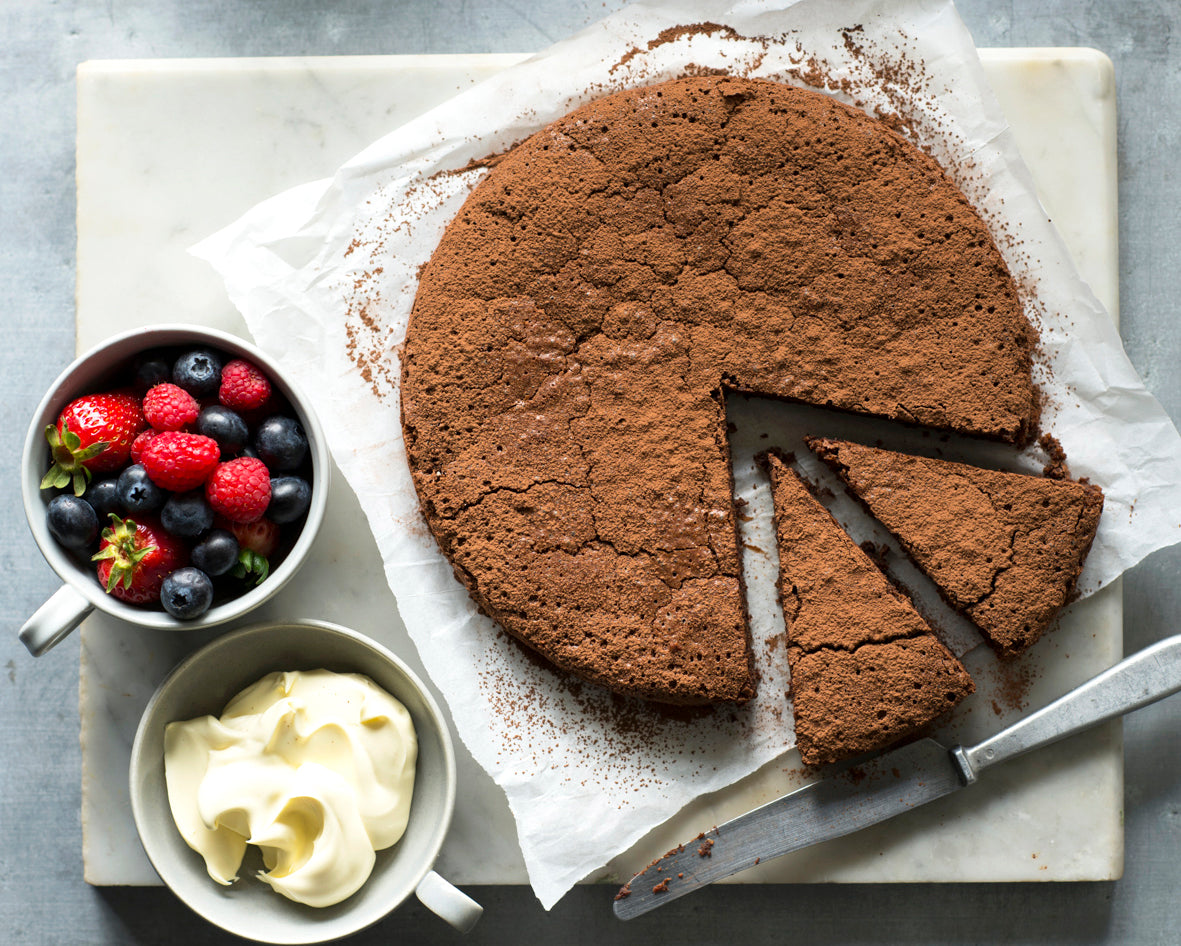
Prep 20minBake 55minMakes 8-10 serves
This cake is a favourite of mine – it is rich but light all at the same time. The chocolate, egg yolks and hazelnut meal provide the richness while the egg whites account for the light texture. It is indulgent without being overwhelmingly rich – my sort of chocolate cake. It makes a perfect dessert when served with thick cream or ice cream but don’t underestimate how blissfully suitable a slice with afternoon coffee can be.
Ingredients
Melted butter, to grease150g good-quality dark chocolate, chopped
100g butter, cubed
4 eggs, at room temperature, separated
110g (½ cup) caster sugar
110g (1 cup) hazelnut meal
2 tablespoons sherry, brandy or Frangelico
Cocoa powder or icing sugar, to dust
Method
- Preheat the oven to 150°C (130°C fan-forced). Grease a 22cm (base measurement) springform tin with the melted butter, then line the base and side with baking paper.
- Combine the chocolate and butter in a medium heatproof bowl over a saucepan of simmering water (don’t allow the bowl to touch the water). Stir occasionally until the chocolate and butter melt and the mixture is smooth. Remove the bowl from the pan.
- Add the egg yolks, sugar, hazelnut meal and sherry to the chocolate mixture and use a balloon whisk to stir until well combined. Transfer the mixture to a large bowl.
- Place the egg whites in a clean, dry medium bowl and use electric beaters with a whisk attachment to whisk until firm peaks form. Add a spoonful of egg white to the chocolate mixture and use a large metal spoon or spatula to fold in – this will ‘loosen’ the mixture. Add the remaining egg white and fold in until just combined.
- Pour the mixture into the prepared tin and use the back of a spoon to smooth the surface. Bake in preheated oven for 55 minutes or until the top of the cake feels set and crumbs cling to a skewer inserted into the centre. Remove the cake from the oven, place on a wire rack and cool completely in the tin.
- Remove the cake from the ti and serve dusted with cocoa powder or icing sugar.
Baker's Tips
- This cake will keep in an airtight container in the fridge for up to 4 days. Bring it to room temperature before serving.
Variations
- Flourless Chocolate & Almond Cake: Replace the hazelnut meal with almond meal.
- Flourless Chocolate & Orange Cake: Replace the hazelnut meal with almond meal. Replace the sherry with 2 tablespoons orange liqueur (such as Grand Marnier or Cointreau). Add 1 tablespoon finely grated orange zest with the egg yolks.
- Flourless Chocolate Coffee Cake: Replace the sherry with 2 teaspoons instant coffee granules dissolved in 2 tablespoons water.
Prep 30minBake 3hr45minMakes about 1 x 20cm cake
This rich fruit cake would be the perfect addition to Christmas lunch – or any other time of the year. You will need to start the day before and prepare the pan accordingly (see the link in the recipe below).
Ingredients
- 300g dried figs
- 200g pitted dates
- 300g dried cranberries
- 200g sultanas
- 200g currants
- 100g raisins
- 110g (⅓ cup) fig jam
- 185ml (¾ cup), brandy, plus 60ml (¼ cup) extra
- 180g unsalted butter, at room temperature
- 110g (½ cup, firmly packed) brown sugar
- 4 eggs, at room temperature
- 200g blanched almonds, plus extra to decorate
- 1 orange, zest finely grated and juiced
- 150g (1 cup) plain flour
- 50g (½ cup) almond meal
- 1 teaspoon baking powder
- 2 teaspoons ground cinnamon
- 1 teaspoon ground ginger
- ¼ teaspoon ground cloves
Method
- Chop figs and dates to same size as sultanas. Put in a large bowl with cranberries, sultanas, currants, raisins, jam and brandy. Cover and set aside at room temperature for at least 1 day.
- Preheat the oven to 150°C. Grease and line the base and sides of a deep square pan with removable base (20cm, top measurement). Prepare the pan for baking a rich fruit cake (Click here for instructions).
- Use an electric mixer to beat butter and sugar until pale and creamy. Add the eggs one at a time, beating well after each addition. Stir in the soaked fruit, almonds, orange juice and zest.
- Whisk together the flour, almond meal, baking powder and spices to combine evenly. Add to the fruit mixture and use a wooden spoon and then your hands to mix lightly until well combined.
- Spoon the mixture into the prepared pan and press into the corners and then smooth the surface (see Baker's Tips). Decorate with extra nuts. Cover the cake with a piece of foil. Bake in preheated oven for 1 hour. Remove the foil and continue to bake for a further 2 hours and 45 minutes or until just cooked when a skewer inserted into the centre comes out clean.
- Pour the extra brandy evenly over the top of the hot cake. Trim any overhanging paper, cover the pan well with foil and then wrap the cake, still in the tin, in two tea towels. Cool overnight.
Baker's Tips
- Before preheating your oven, position the oven rack so that the middle of the cake pan will be in the centre of the oven.
- Before baking your cake, drop the pan on the bench 4-5 times to make sure the mixture fills the corners and gets rid of any unwanted air pockets.
- This cake will keep wrapped in plastic wrap and then foil in an airtight container for up to 6 weeks. If you don't use the nuts, it will last for up to 3 months.
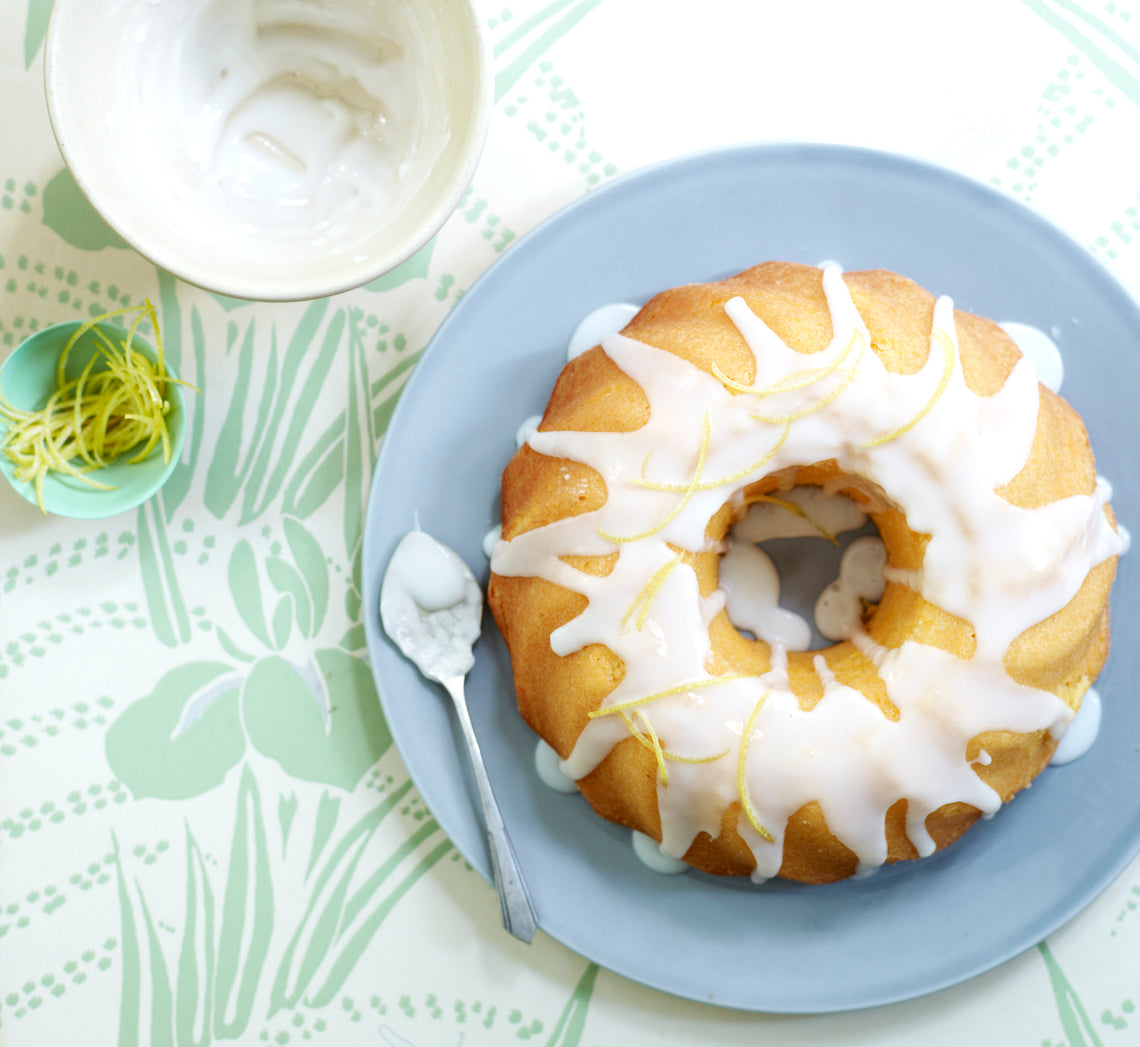
Prep 30minBake 40-45minMakes 10-12 serves
Lemon buttercake is something from heaven – rich, tart and mor-ish all at the same time… And when teamed with coconut it becomes sublime! This cake is particularly good for afternoon tea or dessert when teamed with vanilla ice-cream.
Ingredients
150g salted butter, softened
220g (1 cup) caster sugar
Finely grated zest of 2 lemons
3 eggs
300g (2 cups) self-raising flour
45g (½ cup) desiccated coconut
125ml (½ cup) milk
Candied Lemon Strips
220g (1 cup) caster sugar
250ml (1 cup) water
Lemon Drizzle Icing
125g (1 cup) pure icing sugar4-5 teaspoons strained fresh lemon juice
Method
- Preheat the oven to 170°C (150°C fan-forced). Grease a 24cm (top measurement) or 2.5 litre (10 cup) capacity fluted ring tin with the melted butter and dust with flour to lightly coat, tapping out any excess.
- Use an electric mixer to beat the butter, sugar and lemon rind in a large mixing bowl, scraping down the sides when necessary, until very pale and creamy. Add the eggs one at a time, beating well after each addition until well combined.
- Combine the flour and coconut. Add half of the flour mix to the butter mixture and mix on lowest speed possible until just combined. Add the milk and mix on lowest possible speed until just combined. Add the remaining flour mix and beat on lowest possible speed until just combined.
- Spoon the mixture into the prepared tin and use the back of a spoon to smooth the surface. Bake for 40-45 minutes or until a skewer inserted into the centre comes out clean. Stand the cake in the tin for 5 minutes to cool slightly before turning onto a wire rack sitting over a tray or plate.
- While the cake is cooling make the Candied Lemon Strips. Use a vegetable peeler to remove the rind in wide strips from the lemon. Use a small sharp knife to remove any white pith from the rind and then cut the rind into thin strips. Combine the sugar, water and lemon rind strips in small saucepan. Stir over medium heat until the sugar dissolves. Bring to a simmer and simmer for 10 minutes or until translucent. Use a fork to transfer the rind from the syrup to a plate, separating the strands. Set aside.
- When the cake is cool, make the Lemon Drizzle Icing. Sift the icing sugar into a medium bowl. Add 4 teaspoons of the lemon juice and stir until smooth and is a heavy coating consistency, adding a little more lemon juice, ¼ teaspoon at a time, until the desired consistency is reached. Use a spoon to drizzle the icing over the cake allowing it to run down the sides. Set aside for 10 minutes or until the icing sets.
- Transfer the cake to a serving plate, decorate with the Candied Lemon Strips and serve in wedges.
Baker's Tip
- This cake will keep in an airtight container for up to 2 days.
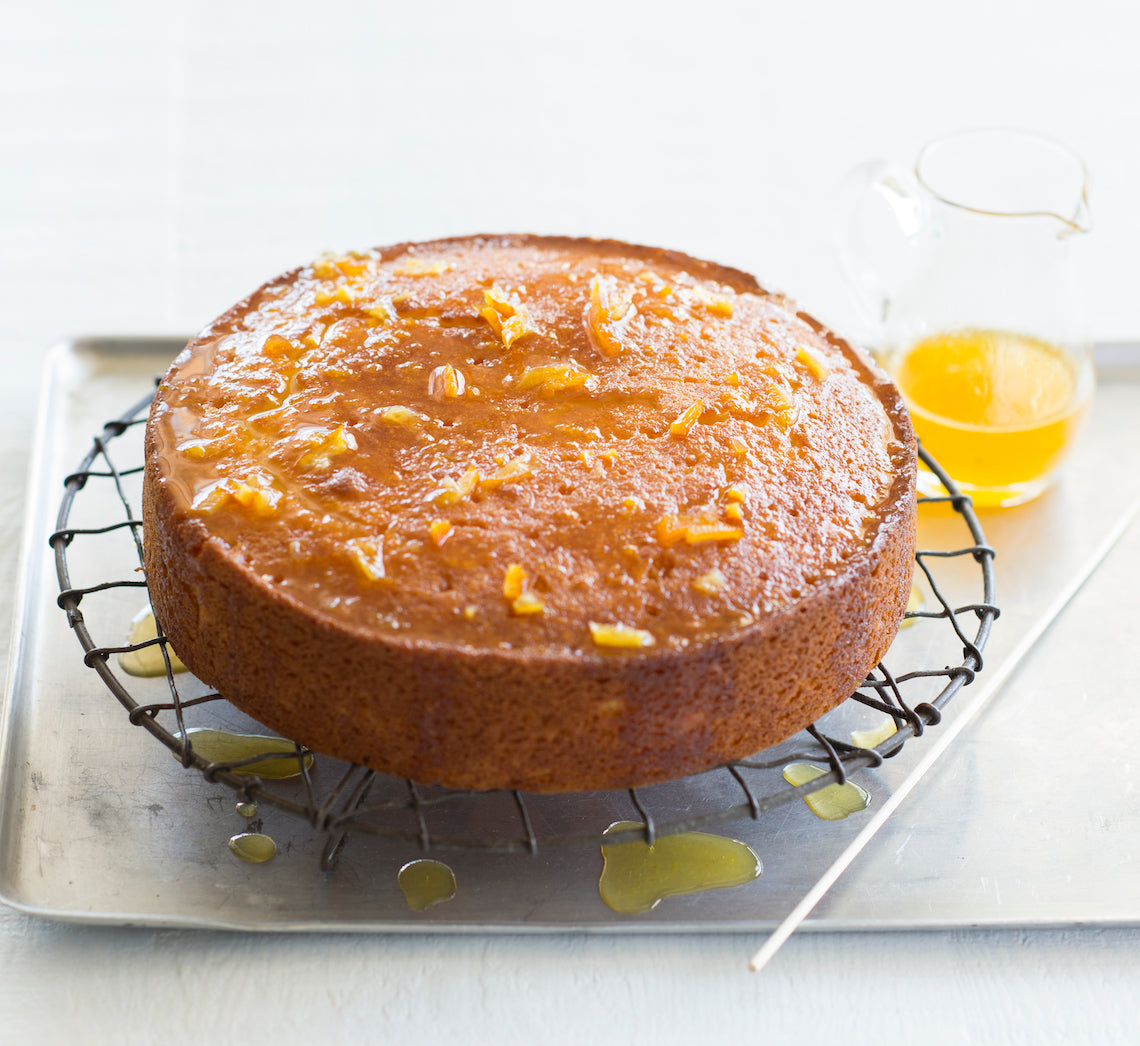
Prep 15minBake 50-60minMakes 8-10 serves
This is a wonderful cake that was originally inspired by a recipe my Aunt Joey used to make. No, it isn’t a mistake, a whole orange, rind and all goes into this cake. It is best to use a thin-skinned navel orange that is around in winter and spring, as it has no seeds and very little bitter pith.
It makes a wonderful dessert when served warm with vanilla ice-cream or a perfect picnic cake as it travels really well. The syrup keeps this cake deliciously moist and saves you from icing it – another great shortcut. If however you would prefer to ice it, a buttercream or glace icing flavoured with finely grated orange zest would be perfect.
Ingredients
Melted butter, to grease
1 orange (about 240g/8½oz), quartered, core and seeds removed
220g (1 cup/7¾oz) caster sugar
125g (4½oz) salted butter, melted and cooled
2 eggs, at room temperature
225g (1½ cups/8oz) self-raising flour
Orange syrup
250ml (1 cup/9fl oz) strained freshly squeezed orange juice
160g (½ cup/5¾oz) orange marmalade
75g (⅓ cup/2¾oz) caster sugar
Method
- Preheat oven to 170°C/340°F (150°C/300°F fan-forced). Grease a 20cm/8in round cake tin with melted butter and line the base with non-stick baking paper
- Place the quartered orange, sugar, butter and eggs in the bowl of a food processor. Process until the orange is finely chopped. Add the flour and process using the pulse button until just combined.
- Pour the mixture into the prepared tin and use the back of a spoon to smooth the surface. Bake in preheated oven for 50-60 or until a skewer inserted into the centre comes out clean. Remove from the oven and set aside for 5 minutes before turning onto a wire rack. Stand the rack over a baking tray.
- Meanwhile, to make the Orange Syrup, place the orange juice, marmalade and sugar in a small saucepan. Stir over medium heat until the sugar dissolves. Increase the heat to high and bring to the boil. Boil gently, uncovered and without stirring, for 5 minutes or until reduced slightly.
- Use a skewer to prick cake all over. Gradually pour the hot syrup over the hot cake, allowing it to soak in. Pour any syrup that has collected on the tray into a dish or jug, Serve warm or at room temperature with any syrup caught on the tray in a jug on the side.
Baker's Tips
- This cake will keep in an airtight container at room temperature for up to 4 days.
Image: Alan Benson






